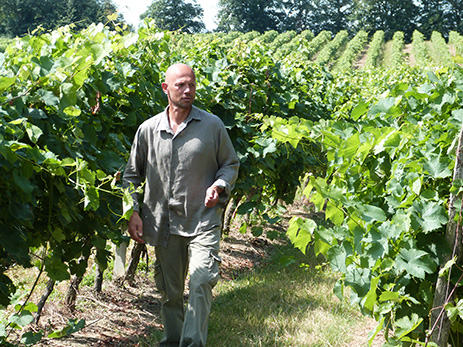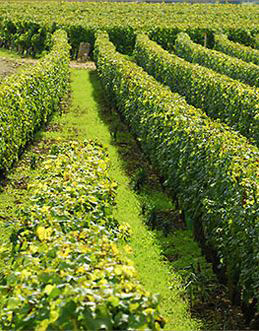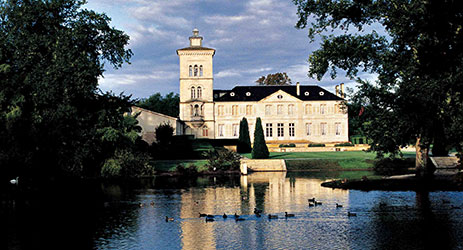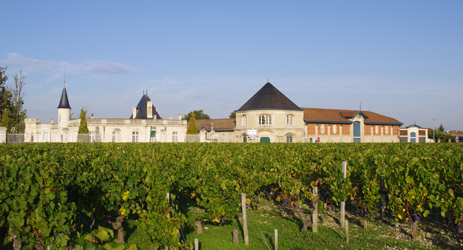Emmanuel Labergère describes himself as a geo-biologist, but I’m finding it hard to think of him in any other way than a vine whisperer.

I came across his name when I was researching for an article on Durfort Vivens, the 1855-classified biodynamic estate in Margaux. He consults in the vineyard, working alongside their usual team of consultants. I had to look up the term ‘geo-biologist’, and wasn’t having much luck in deciphering a satisfactory definition, but there was one small article on Labergère himself, in the local Bordeaux paper dating from 2011, which described him as a ‘healer’ who worked in the vines.
When I met him, he was quick to say that he doesn’t like the term healer. ‘And please don’t talk about visions. I prefer to keep things as practical and grounded as possible. I am not doing anything extraordinary really – our forefathers understood much of my work, and called it ‘le bon sens paysan’ (farmers’ wisdom). It’s about intuition and being open, stilling the intellectual part of your brain and letting instinct take over.’
Labergère – my only interview to date who has taken his shoes off almost immediately upon arriving at my house, and who I happily chatted with for several hours, both barefoot in the garden – today works with around 20 different estates in the Loire Valley, Bergerac, Gascony and Bordeaux. Some of them want to remain anonymous, but among those happy to be name-checked are Chateaux Durfort Vivens, Climens, Desmirail, Lagrange, Clos Puy Arnaud, and Menétou-Salon.
Clearly, there is not a tried-and-tested career path to becoming a vine whisperer. In Labergère’s case, he spent his first 20 years in wood, working in logistics and production in the furniture industry. ‘I was always attracted by the forest, but wanted to work with living trees. Instead I found myself spending my day with dead ones’.
A chance meeting around six years ago with a healer convinced him of his own potential, and he began to take tentative steps to treating friends with specific ailments, until his brother – who worked at the time at Chateau de Malle in Sauternes, and is now at Chateau Rayne Vigneau – asked him to come to the cellars and see if he could apply his unusual talent to wine. ‘When I put my hands over the barrel, I could see the form of the wine, and could speak about it more precisely than I ever could if I was tasting it. My brother later showed me a map of the vineyard, and even without going in to the vines, I could see the soil, the roots, what the vines needed’.
Labergère has an undeniable energy to him. He’s a moving target to interview, standing frequently and talking with his whole body. He’s also disarmingly honest. ‘I have never opened a wine book. I don’t know exactly how things should work technically, and yet I am able to give directions that wine experts can make sense of and action. I somehow can sense what the vines need. But I always work best when I am asked specific questions, and I become a conduit for the answers’.

Bérénice Lurton, who has worked with Labergère for two years at Chateau Climens alongside her biodynamic consultant Corinne Comme, agrees. ‘You can almost ask questions of the vines through him. He helps us to listen to our own intuition, to better understand what might be wrong with particular plots of vines. It’s a fascinating process, and as soon as you work with him you are convinced.’
‘I believe vines have a life force that is stronger than many other plants,’ says Labergère. ‘I can hear them telling me what they need - nitrogen, magnesium, less water, a different training or pruning system, more drainage, whatever – and I report the information back. I don’t always know what it means while I am saying it, I don’t always remember it afterwards, and I don’t always know the effects will be.’
Labergère never worked in any official capacity for Chateau de Malle, but his brother spoke to directors of other chateaux, and little by little they began to ask him to come to see them, often anonymously at first, and usually only after exhausting all other avenues. Today vineyards make up 80% of his consultancy. He works with several biodynamic estates – Climens, Durfort Vivens and Clos Puy Arnaud among them – but his work is not confined to those. ‘Of course biodynamic estates are more open to different ways of doing things, but it is more about creating harmony in a property. In Eauze I work with a farmer who has 500 hectares in traditional farming. He wants to use as little chemical treatments as possible, so I help him eliminate the worst ones, and limit the doses. Often we find we are using 25% of the official instructions, with the same results.’
Measuring effectiveness can be instant – often technical directors will start off asking questions they already know the answers to, to ‘test’ his abilities, and then move on to more intractable issues such as underperforming plots, abnormally low yields, or stuck fermentations in the cellar.
‘The issue that I come across most frequently is too much copper in the soil, that may date back many years and is often found in stagnant water maybe 15 metres below the surface. We then put in practical steps to evacuate the water, or plant things that will compensate.’
Clearly you have to take a certain leap of faith to work with a geo-biologist, still more if you are willing to think of him as a vine whisperer. But he is in no rush to convert the skeptics. ‘Everyone is free to believe or not, I am not a missionary, and no-one is dependent on me. I am just part of the puzzle.’ And with that he recounts how Gonzargue Lurton, owner of Durfort Vivens, came out into the vines one day to observe his work. He stood silently by, saying nothing while Labergère and his own technical director went about their tasks.
Afterwards he approached Labergère and said simply. ‘I can’t explain what you are doing, but I can see the results.’

Columnist Introduction
Jane Anson is Bordeaux correspondent for Decanter, and has lived in the region since 2003. She is author of Bordeaux Legends, a history of the First Growth wines (October 2012 Editions de la Martiniere), the Bordeaux and Southwest France author of The Wine Opus and 1000 Great Wines That Won’t Cost A Fortune (both Dorling Kindersley, 2010 and 2011). Anson is contributing writer of the Michelin Green Guide to the Wine Regions of France (March 2010, Michelin Publications), and writes a monthly wine column for the South China Morning Post in Hong Kong, where she lived from 1994 to 1997. Accredited wine teacher at the Bordeaux Ecole du Vin, with a Masters in publishing from University College London.
Click here to read all articles by Jane Anson>>
- Follow us on Weibo @Decanter醇鉴 and Facebook
and Facebook for most recent news and updates -
for most recent news and updates -
All rights reserved by Future plc. No part of this publication may be reproduced, distributed or transmitted in any form or by any means without the prior written permission of Decanter.
Only Official Media Partners (see About us) of DecanterChina.com may republish part of the content from the site without prior permission under strict Terms & Conditions. Contact china@decanter.com to learn about how to become an Official Media Partner of DecanterChina.com.



Comments
Submit